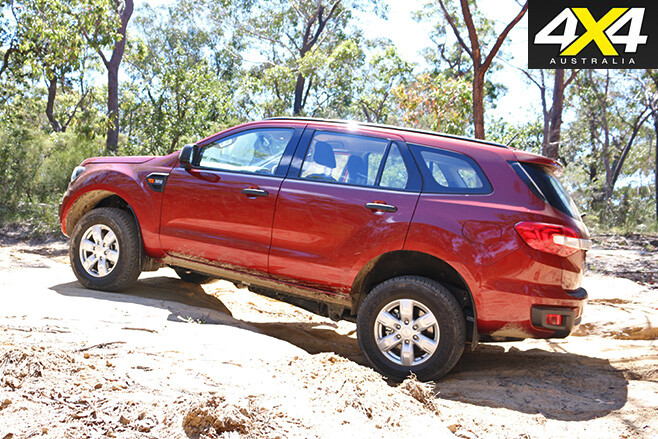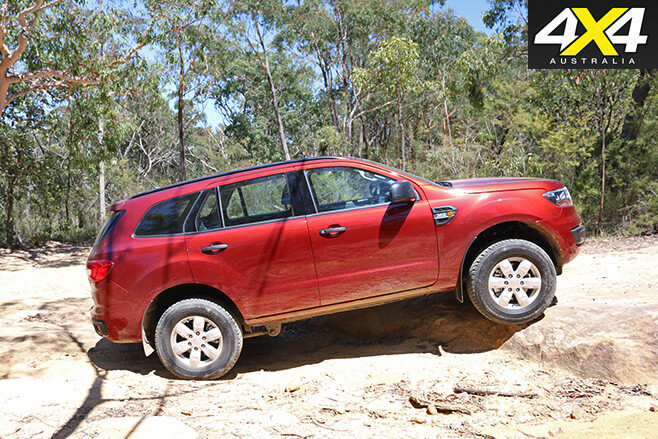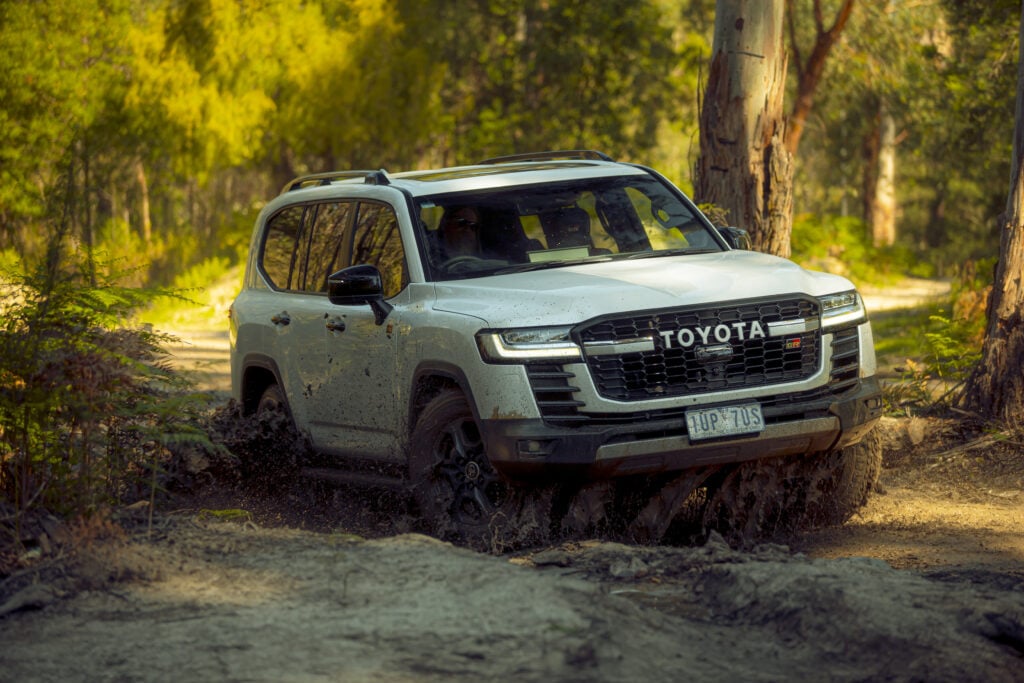While the Everest is based on the chassis of the Ranger, it is priced higher than most other ute-based SUVs.
That’s because Ford sees it competing more with the hugely successful Toyota Prado.
WHAT’S THE DEAL?
The price of entry for the basic Ambiente (the model we’ve tested here) is $54,990 (plus on-road costs). For that you get 17-inch alloy wheels, auto headlights, rear parking sensors, a reversing camera, and the usual array of cruise control and Bluetooth connectivity.
However, the central screen that displays information for the sound system and phone is tiny, at just 4.2 inches across the diagonal.
Step up to the Trend ($60,990) and the wheels go up to 18 inches and the cruise control gets an active feature that uses radar to lock on to the car in front. The pokey touchscreen is replaced with an 8-inch unit teamed with the Sync voice-operated infotainment system. And there are extras such as tinted windows, a powered tailgate, rain-sensing wipers, side steps and dual-zone air-conditioning. Active safety gear includes forward collision warning and a lane keeping system.
From there it’s a big step up to the flagship Titanium ($76,990), which adds leather seats, adjustable ambient lighting inside, heated front seats, sat-nav, panoramic sunroof and blind spot warning. The wheels step up to 20-inch units and come with a tyre-pressure monitoring system.
However, there’s no smart key entry on any model and, like the Ranger it’s based on, the Everest misses out on reach adjustment for the steering.
A towbar is $1000 on all models.
PRACTICALITY
There’s a relatively high floor on the Everest, which makes for a decent climb into the cabin, especially on the Ambiente, which does without side steps. Once there, it’s a comfortable place with good front seats and plenty of binnacles for odds and ends. It’s a shame about that lack of reach adjustment to the steering wheel, which would top off an otherwise great driving position.

Adults in the middle row are almost short of headroom, but – as with the third row – at least there’s a stream of fresh air thanks to the roof-mounted vents. The middle row slides forward and back and can be folded flat using a separate lever.
The third row split-folds into the floor. One bonus for those with kids is the flexibility of where you can place child seats. While most 4WDs only have top tether points in the centre row of seats, the Everest also gets them in the third row. Sure, it doesn’t leave much room for luggage with all seven seats in play, but it’s great for when your 4×4 is confined to the suburbs.
ON THE ROAD
Ute-based SUVs often feel pretty rugged in regular driving, but the Everest sets a high standard. The highlight is its refinement. While the 3.2-litre five-cylinder diesel can be heard, it’s nowhere near as vocal as it is in the Ranger. Put that down to some clever noise cancelling; three microphones in the roof monitor noise coming from under the bonnet and send opposing frequencies through the speakers to significantly hush the cabin. Road and wind noise, too, are well contained, making for a relaxed cruiser.
Through corners the Everest does a good job dealing with its relatively high centre of gravity. The steering is light yet accurate and decent body control makes the whole equation fairly viceless. And having the permanent 4WD system gives you confidence punching out of intersections or slippery hairpin bends.
The turbo diesel has plenty of grunt – 143kW and 470Nm – but it’s lugging around a big vehicle in the Everest; even the base Ambiente is 2370kg, with the top-whack Titanium just shy of 2.5 tonnes. Still, the easily accessible low rev torque makes for respectable progress. And the six-speed auto is pretty cluey, holding gears on descents and decisively plucking lower gears as required when accelerating.
OFF-ROAD
While it’s based on the Ranger, the Everest is a quite different beast off-road. That’s due mainly to its unique four-wheel drive system. The full-time system uses a torque-on-demand system to apportion drive front and rear.
The Everest also gets a Terrain Management System, which alters the throttle response, gear changes and traction control for different conditions.
In Snow/Grass/Gravel it reduces throttle sensitivity and upshifts sooner to use the torque and maximise traction. In Sand it holds gears longer to allow for higher revs and allows for more wheel slip to maintain momentum; the torque delivery and throttle sensitivity are also high. Rock mode is only allowed in low range and locks the transmission in first gear (which can be frustrating if you’ve got short bursts of dirt track between rocky patches); it also reduces throttle sensitivity but has a more aggressive traction control mode to reduce wheel spin.

As well as hill descent control – commonplace on modern SUVs, even the soft ones – the Everest gets hill ascent control, for controlled low-speed throttle applications when climbing steep grades. The speed of each can be adjusted by blipping up and down on the gear selector manual mode.
It’s all clever stuff and, importantly, all works well to make for easier progress in more challenging terrain. It teams with a decent 225mm of clearance, good approach and departure angles and good underbody protection to make for a very capable and easy to use off-roader. Throw in the 800mm wading depth and the Everest cements itself as one of the best in the business.
VERDICT
The Everest is a big step up for ute-based SUVs – but you pay for it. Its pricing if against the legendary Toyota Prado is bold. Yet the main things it lacks are headroom in the middle row and an extended fuel tank.
Otherwise, there’s a clever 4×4 system setting the foundation for excellent off-road performance. Throw in great on-road manners and excellent refinement and the Everest is a fine 4×4.
Price and specifications
Price: $54,990
Engine: 3.2-litre five-cylinder turbo diesel, 143kW at 3000rpm, 470Nm at 1750-2500rpm
Transmission and 4WD system: Dual-range torque on demand full-time 4WD
Braked tow capacity: 3000kg
Spare tyre: Full size
Fuel tank: 80 litres
Fuel use (claimed): 8.5L/100km
Fuel use on test: 11.3L/100km
Approach/departure angles: 29.5 degrees/25.0 degrees
Ground clearance: 225mm





